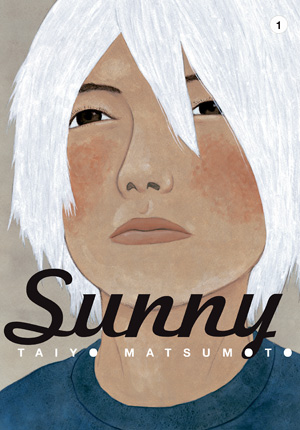Download as PDF
 Sunny
Sunny
Written and illustrated by Taiyo Matsumoto
Translated by Michael Arias
VIZ Media LLC, 2011, 224pp.
ISBN: 1421555255
Sunny is Taiyo Matsumoto’s autobiographical youth manga, set in rural 1970s’ Japan. The story portrays the everyday life of foster children, ranging from toddlers to teens, who live in a foster home called the “Star Kid Home.” The children come from different problematic situations, including broken homes and dysfunctional families. Sunny 1200, a broken down yellow Nissan sitting in the back yard, is an important shared space for them. Within the car and their imaginations, they can become anyone and go anywhere, such as outer space, fantasy lands, or simply home. They share concerns and worries, and sometimes smoke and read forbidden porn magazines in secret.
Sunny consists of six chapters. Each chapter concentrates on one child’s life story or tells a tale from his or her perspective. The stories are low-key without much dynamic action, but are never boring. As readers, we empathize with the children’s feelings of abandonment, loneliness, distress, desperation for familial love, strengths, and sensitivities. These are delineated in black-and-white details, and occasionally in colored, washy ink illustrations. Readers are not told why Haruo, one of the children, always carries Nivea cream, but he is shown smelling the cream when he misses his mother and shares the pain of loneliness with others by having them smell it. There is no narrative to describe why Kenji comes to the foster home, but he is shown visiting his alcoholic father and taking care of him. During winter, Sei comes to the home from Yokohama. His parents promise to come back and pick him up before summer, but they never reappear. Sei does not lose hope and is always ready to go back to Yokohama. Although the other children soon get used to speaking in the town’s dialect, Sei never changes his ways, and that seems like a sign of his resistance against fitting into the foster home as he clings to his sense of belonging with his parents.
This powerful story about foster children and their resilience can be paired with Nobody Knows by Shelley Tanaka (2012), a contemporary realistic fiction based on a true story set in Japan. This story portrays abandoned siblings and their struggles. Harry Potter is also a great narrative for exploring the lives of abandoned children through Harry’s and Neville Longbottom’s experiences. Harry, for example, shows his desolation with his foster family and his resistance to them along with his resilience. Foster teens’ experiences can be seen in other realistic fiction stories such as Pictures of Hollis Wood by Patricia Reilly Giff (2002) and The Great Gilly Hopkins by Katherine Paterson (1978). Picturebooks such as Kids Need to Be Safe: A Book for Children in Foster Care by Julie Nelson (2005) and Maybe Days: A Book for Children in Foster Care by Jennifer Wilgocki (2001) address foster children’s questions, feelings, and concerns.
Taiyo Matsumoto won the Eisner Award for his youth manga Tekkon Kinkreet: Black & White (2007). He is one of Japan’s most acclaimed manga artists and children’s literature authors. Sunny was nominated for the 2014 Great Graphic Novel Award by the American Young Adult Library Services Association, and won the 2016 Shogakukan Manga Award, one of the most prestigious awards for manga artists in Japan. Sunny continues with six more volumes, available in English in the US. These volumes dig into the foster children’s personalities, development, and family and peer cultures. Tail Matsumoto’s website is run by one of his fans and provides accurate information on his past and recent works.
Junko Sakoi, Tucson Unified School District, Tucson, AZ
WOW Review, Volume X, Issue 1 by Worlds of Words is licensed under a Creative Commons Attribution-NonCommercial-ShareAlike 4.0 International License. Based on work at https://wowlit.org/on-line-publications/review/x-1/
